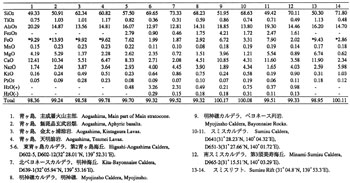Aogashima Volcano
1: Introduction / Aogashima Volcano
2: Geology and geohistory of Aogashima Volcano / Activities in historical times before the years of Tenmei / Eruptions from 1781 to 1785
3: Rocks
4: Subsurface structures / Surveillance and observation of volcanic activities / Prediction of future activities and hazard
5: Volcanoes accompanying submarine calderas on island arc setting
6: Volcanoes within back-arc rift setting / Surveillance, observation, and prediction of future activities and hazard of submarine volcanoes
7: References
![]() PREV
PREV ![]() NEXT
NEXT
Rocks
SiO2 contents of rocks of Aogashima are within the range of 49-63 %. However, they are mostly tholeiitic basalt ( ![]() Table 1 ) . Aogashima Volcano is composed of several small stratovolcanoes with multiple craters. The chemical compositions are slightly different from one crater to the other ( Takeda et al., 1992 ). Kurosaki Volcano consists of olivine basalt, clinopyroxene-olivine basalt, and clinopyroxene-orthopyroxene andesite. Main part of stratovolcano consists of olivine basalt and clinopyroxene-bearing olivine basalt. Little amount of clinopyroxene-orthopyroxene andesite lava is distributed in addition. Essential materials of aphyric basalt and Ojiroike surge deposits consist of almost identical rocks. Kintagaura lava and Yasundogo fall deposits are made up with olivine basalt, and clino- and ortho-pyroxene andesite. Lavas of Tenmei eruption are clinopyroxene-orthopyroxene-bearing aphyric andesite.
Table 1 ) . Aogashima Volcano is composed of several small stratovolcanoes with multiple craters. The chemical compositions are slightly different from one crater to the other ( Takeda et al., 1992 ). Kurosaki Volcano consists of olivine basalt, clinopyroxene-olivine basalt, and clinopyroxene-orthopyroxene andesite. Main part of stratovolcano consists of olivine basalt and clinopyroxene-bearing olivine basalt. Little amount of clinopyroxene-orthopyroxene andesite lava is distributed in addition. Essential materials of aphyric basalt and Ojiroike surge deposits consist of almost identical rocks. Kintagaura lava and Yasundogo fall deposits are made up with olivine basalt, and clino- and ortho-pyroxene andesite. Lavas of Tenmei eruption are clinopyroxene-orthopyroxene-bearing aphyric andesite.
